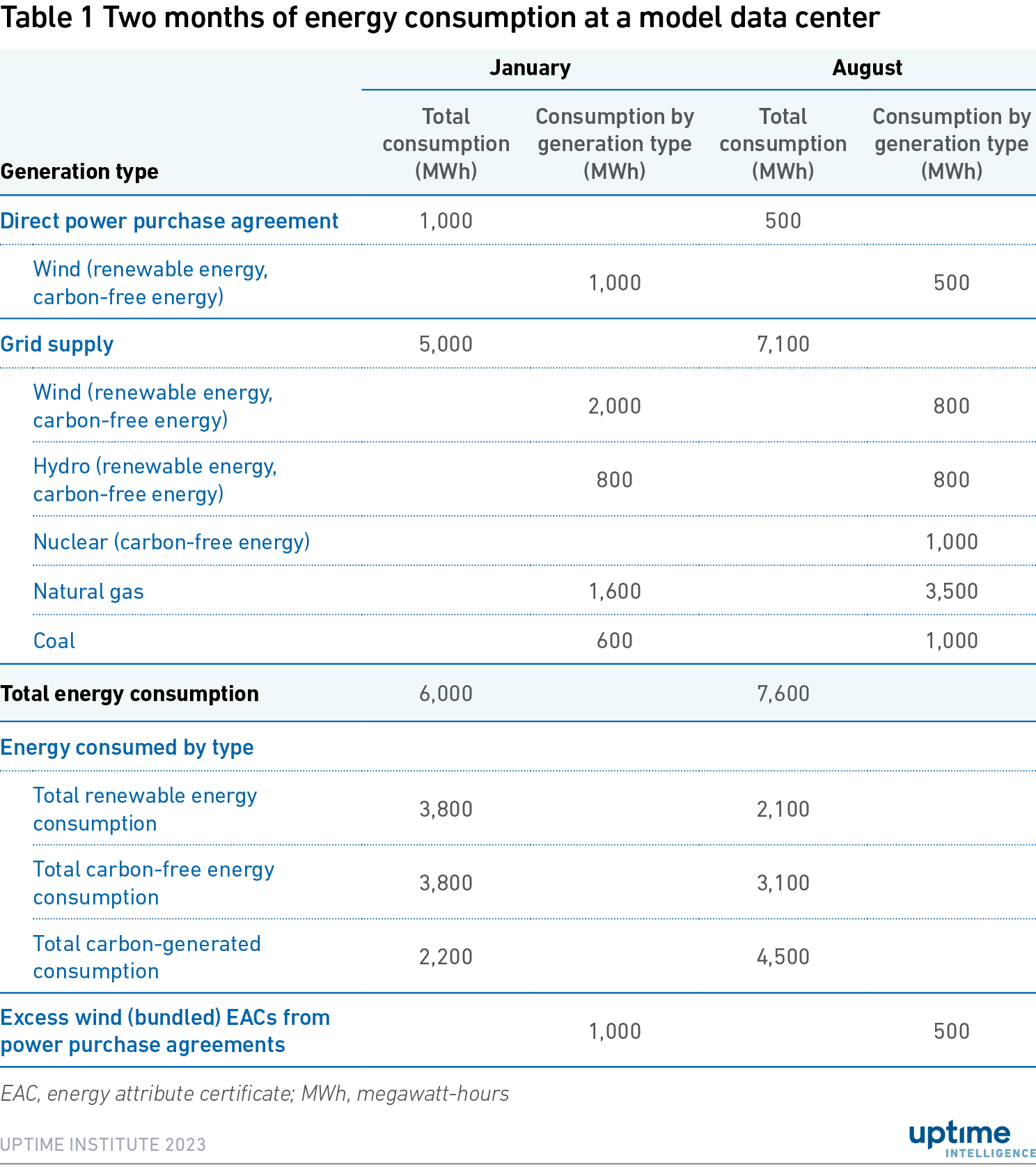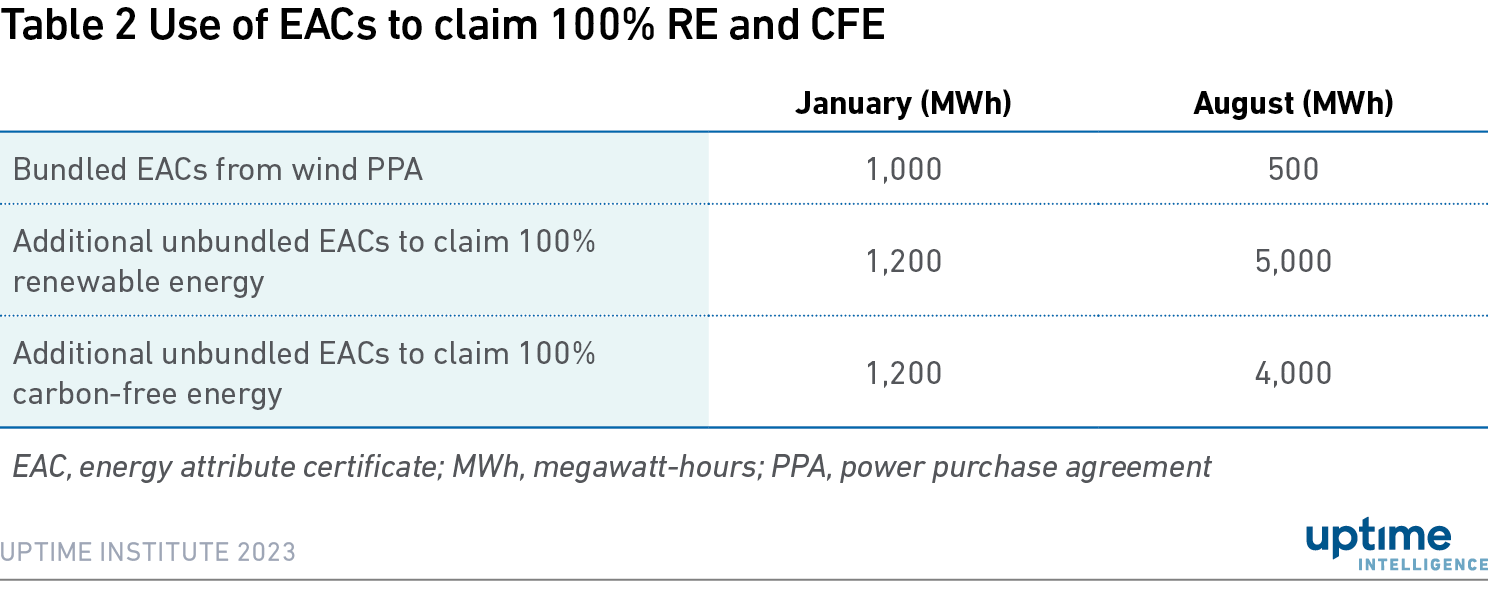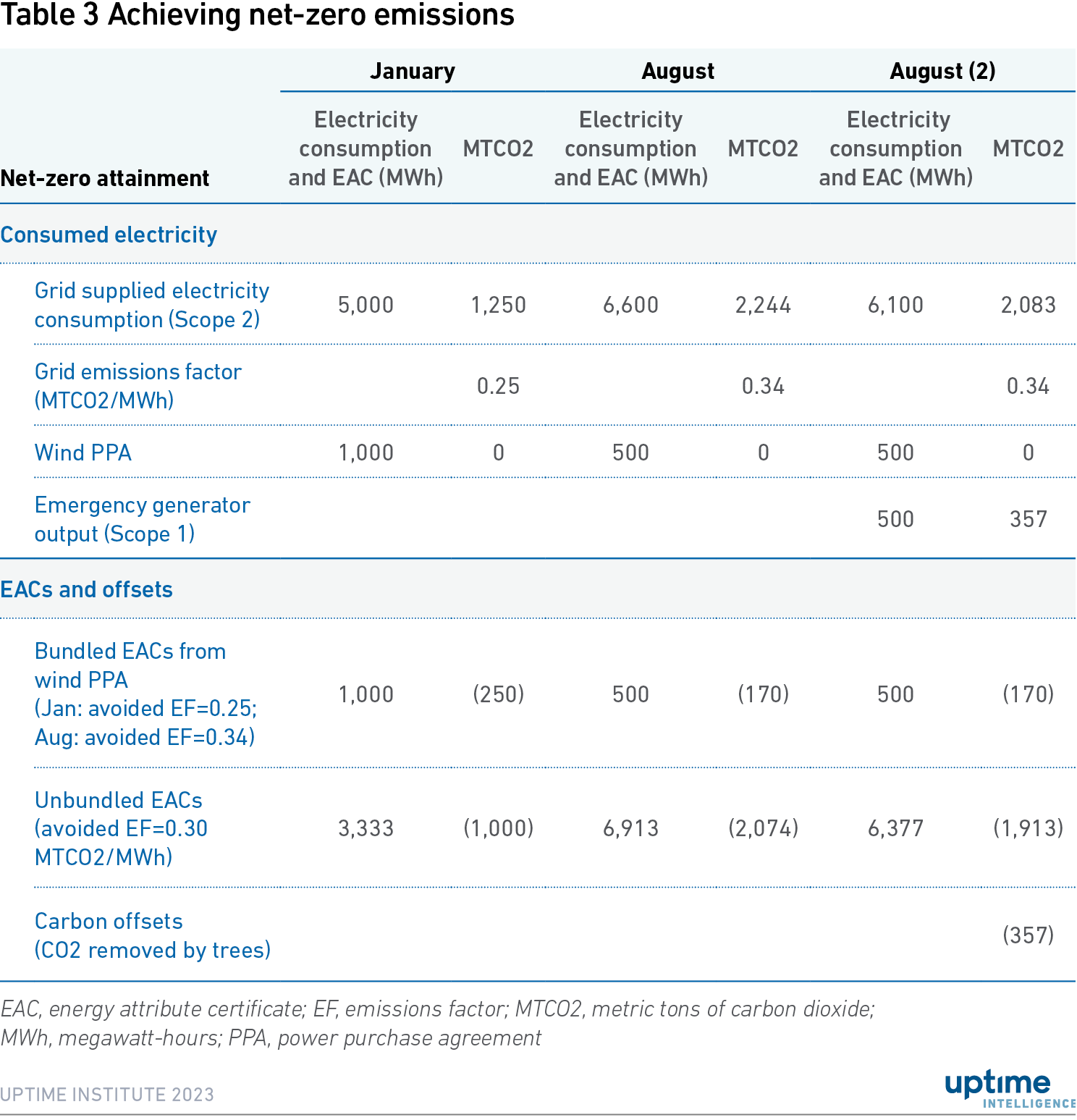UII BRIEFING REPORT 118 | DECEMBER 2023
Briefing Report
Accounting for net-zero emissions and carbon-free energy goals
Digital infrastructure managers face a daunting challenge to calculate and validate their renewable energy (RE) or carbon free energy (CFE) and net-zero goal results. Accurately accounting for these goals requires knowing the quantity and generation source(s) of electricity consumed at a facility, the emissions factor of the grid supplied electricity, and the emissions factors of the bundled and unbundled energy attribute certificates procured to offset emissions. This report explains the nuances of using energy consumption, energy attribute certificates and emissions factor data to calculate the use of RE and CFE, and a Scope 1 and 2 emissions inventory.
KEY POINTS
- Digital infrastructure managers are expected to set and achieve both a 100% RE or CFE goal and a Scope 1 and 2 net-zero emissions goal.
- Managers need to know the quantity of electricity consumed, the percentage of the electricity delivered by each generation type (such as solar and natural gas), the emissions factor of the supplied electricity to calculate the Scope 1 and 2 emissions, as well as the megawatt-hours (MWh) of fossil fuel consumed.
- A 100% renewable energy RE or CFE goal is typically achieved by offsetting the fossil fuel and nuclear (for a RE goal) generated MWhs with RE environmental attribute certificates (EACs).
- A net-zero emissions goal is achieved by maximizing the MWhs of CFE consumed at the data center to minimize the emissions, and offsetting the remaining emissions with EACs. The number of EACs will depend on the EACs avoided emissions factor.
Introduction
Many digital Infrastructure managers have set aggressive net-zero greenhouse gas (GHG) emissions goals and 100% renewable energy (RE) or carbon-free energy (CFE) consumption goals for their data centers. These goals are both compatible (CFE needs to be consumed to achieve a net-zero emissions goal) and mutually exclusive (achieving a 100% CFE or RE goal does not guarantee achieving a net-zero emissions goal). To achieve and maintain these goals against their commitments, managers will need to review and reimagine their electricity procurement strategies.
At present, the power supplied by most utilities is far from being 100% zero carbon. This means that managers with zero-carbon goals need to take action to integrate their grid electricity purchases with purchases from carbon-free or renewable electricity generation projects (collectively referred to as CFE). They need to maximize the consumption of CFE and minimize the emissions factor of the consumed electricity to bring the emissions associated with electricity consumption as close to zero as practicable (see 24x7 carbon-free energy (part one): expectations and realities).
Most data center facilities will not be able to reach zero-carbon energy consumption or net-zero emissions this way. Any remaining consumption of fossil fuel-generated electricity and the associated emissions will likely have to be offset with renewable energy certificates (RECs) or guarantees of origin (GOs) — collectively referred to as energy attribute certificates (EACs) — from RE generation sources.
Documenting the carbon content of the total energy consumed (or to be consumed) and assessing how that matches against a net-zero emissions objective can involve a complex calculation that requires knowledge of the grid generation portfolio, the megawatt-hours (MWh) of output by each generation type, the overall grid carbon dioxide equivalent (CO2e) emissions factor, and the number and type of EACs and their avoided emissions factors.
This report explains some of these complexities and helps managers understand how they can design and document an energy purchasing policy to align with corporate net-zero goals.
Developing a 100% RE or CFE strategy
Meeting a 100% RE or CFE goal requires managers to match all the energy they consume with an equivalent amount of RE or zero-carbon energy that they generate or buy. This number is a combination of the MWh of RE and CFE sources in the grid electricity, direct purchases of RE or CFE that can be matched to electricity consumption, and the application of a MWh EAC (offset) against each MWh of fossil fuel-generated electricity consumed from the grid. To make this match, the MWh of carbon-free and fossil fuel generation in the grid supply for a reporting period (typically a calendar year) must be estimated from generation data maintained by the energy retailer, utility or the grid region that supplies electricity to the data center.
Until recently, managers have almost exclusively set goals to consume 100% RE generated from wind, solar and hydropower sources that depend on the “fuel” supplied by the natural environment. Many digital infrastructure managers are expanding their goals to include CFE sources, such as nuclear and electricity generation systems that use zero emissions green hydrogen or biofuels. A 100% RE goal cannot count MWhs from nuclear generation because, although it has zero emissions, it is not defined as a renewable source. CFE goals simplify accounting, capture all the zero emissions generation sources used to supply electricity to a facility, and avoid the need to apply EACs to a carbon-free generation source to make a 100% RE claim.
Table 1 provides examples of two months of energy consumption at a data center. The digital infrastructure operator has a direct power purchase agreement (PPA) with a wind generation facility and sources the remainder of its energy from a utility with varying quantities of wind, natural gas, coal, hydro and nuclear generation.
The output profile changes from month to month. In January, wind generation output is high and there is no nuclear output due to a scheduled maintenance shutdown. Because of the high wind output, less natural gas and coal generation output is required to match generation and demand on the grid. In August, wind generation is reduced, with the grid depending on fossil fuel and nuclear generation to match supply to demand.
Half of the MWh generated by the wind PPA can be directly consumed at the data center; the wind generation occurs simultaneously and in the same grid as the data center consumption. The other 50% of the MWh generated are sold into the grid spot market, with the data center retaining the EACs to offset the grid electricity purchases. These bundled EACs are applied to the grid-purchased electricity as offsets to meet the 100% RE, CFE and net-zero emissions goals.
The data center energy consumption varies by month because of changes in IT workload and greater cooling demand in the summer.

A digital infrastructure manager needs to track their energy supply and consumption to account for the monthly variations in consumption and output of the different generator types supplying the data center. Due to the monthly changes in the quantities of RE, CFE, and carbon-generated electricity consumed by the model data center, the manager needs to procure different quantities of EACs to claim 100% CFE or RE consumption (Table 2).

In January, the high wind output reduces the quantity of carbon-generated energy in the grid supply. The quantity of RE in the grid mix matches the CFE generation due to the nuclear plant shutdown. 1,200 additional EACs must be procured and combined with the 1,000 EACs generated from the wind PPA to offset the 2,200 MWh of fossil fuel generation and to be able to claim 100% RE and CFE consumption.
In August, the fall-off in wind generation reduces both the MWh of RE consumed and the quantity of bundled EACs available to the data center from the PPA. The nuclear generator provides 1,000 MWh of CFE that offsets some of the reduction in wind generation. However, the significant drop in wind generation and the increase in data center energy consumption due to increased demand increases the carbon-generated electricity consumption. A claim of 100% RE consumption will require the procurement of 5,000 MWh of additional EACs (combined with the 500 bundled EACs produced under the PPA) to offset the MWh of carbon- and nuclear-generated electricity. Only 4,000 MWh of EACs (again combined with the 500 bundled EACs) are required to match the 4,500 MWh of carbon-generated electricity to make a 100% CFE claim.
Bundled or unbundled EACS: considerations
There are two types of EACs: bundled and unbundled. To make a 100% REC or CFE consumption claim, a MWh of either type can be applied to offset a MWh of carbon-generated electricity.
When applying a bundled or unbundled EAC to claim a net-zero emissions goal, it is necessary to know the EAC avoided emissions factor to calculate the number of EACs needed to offset the grid mix GHG emissions. It is important to understand the difference between these two types of EACs.
Bundled EACs
Bundled EACs are created in the grid region that supplies energy to the data center. Each EAC has an avoided emissions factor equal to the grid emissions factor for the period represented by the EAC (hourly, daily, monthly or yearly). A bundled EAC can be used to claim 1 MWh of zero emissions for 1 MWh of electricity supplied by the grid.
To make a net-zero emissions claim, the number of bundled EACs used must be equal to the MWh of grid electricity consumed at the data center. This is because the grid emissions factor is the total emissions divided by the total MWhs generated by the RE, CFE and fossil fuel electricity generators. More bundled EACs may be needed to achieve a net-zero emissions claim than a 100% RE or CFE claim because the manager needs to match the total MWh of grid supply, not just the MWh of fossil fuel generation supplied by the grid.
Unbundled EACs
Unbundled EACs are generated in a different grid region from the consumed electricity and their avoided emissions factor will differ from the emissions factor for the electricity sold to the facility. To make a net-zero emissions claim, the avoided emissions factor of the unbundled EAC must be divided into the total emissions from the grid supply to calculate the number of unbundled EACs needed to offset the grid emissions.
Calculating a net-zero goal
GHG emissions from electricity purchases are estimated by multiplying the MWh of consumed electricity by the emissions factor (the average quantity of carbon in each MWh of electricity for a given period) for each generator or group of generators. The grid emissions factor should be available from the energy retailer or utility that supplies the electricity. If not, organizations such as the International Energy Agency and the US Environmental Protection Agency publish annual grid emissions factors by country or grid region.
As a starting point, digital infrastructure managers should determine the quantity of emissions associated with the energy consumed at the data center. In the example (Table 3), this is a combination of the electricity supplied from the wind PPA, which has zero emissions, and the electricity supplied from the grid, which has 1,250 MTCO2 (0.25 MTCO2/MWh) emissions in January and 2,244 MTCO2 (0.34 MTCO2/MWh) emissions in August. The GHG Protocol Scope 2 Guidance refers to these emissions as “location-based” emissions. This information is necessary for reporting as well as to determine the quantity of EACs required to achieve net-zero emissions.

Once the total emissions for a given period are calculated, the number of EACs needed to achieve net-zero emissions can be calculated. The relative value of the grid emissions factor and the emissions factor(s) of the purchased EACs affect the number of EACs required to achieve a net-zero emissions goal at a data center. In the case of the model (Table 3), the digital infrastructure manager offsets the grid emissions with bundled EACs from the wind PPA and purchases of unbundled EACs with an avoided emissions factor of 0.30 MTCO2/MWh (on an annualized basis).
In January, the wind PPA generated 1,000 bundled EACs with an avoided emissions factor of 0.25 MTCO2/MWh, offsetting emissions from 1,000 MWh of grid electricity (250 MTCO2). This left 1,000 MTCO2 emissions, which are offset with 3,333 unbundled EACs (1,000 MTCO2/0.30 MTCO2/MWh). Because the emissions factor of the unbundled EAC is higher than the grid emissions factor, each EAC offsets the emissions from 1.3 MWh of grid electricity consumption.
In August, the wind PPA had lower production, producing only 500 MWh of electricity for consumption and 500 bundled EACs (170 MTCO2). The higher data center electricity consumption with a higher emissions factor for each MWh results in 2,074 MTCO2 of grid-based emissions that are offset by 6,913 unbundled EACs. Because the grid emissions factor is higher in August, each unbundled EAC only offsets emissions from 0.88 MWh of grid electricity consumption.
The use of an emergency generator system for two days (500 MWh) to power the data center — Table 3, August (2) — creates a wrinkle in achieving net-zero emissions using offsets. The 357 MTCO2 emissions from the diesel fuel used to power the generator are a Scope 1 emission. EACs can only be applied to Scope 2 emissions (emissions associated with energy purchases); they cannot be used to offset direct emissions. To achieve net-zero emissions, carbon removal offsets must be purchased to address the 357 MTCO2 emitted by the operation of the diesel generators.
The model illustrates another challenge in using bundled and unbundled EACs for net-zero targets. The data center energy use and emissions and the emissions factor of the bundled EACs are tracked using monthly data, but the unbundled EACs have an annual emissions factor. As emissions tracking systems become more granular, estimating the number of EACs and offsets will become more complicated. The process is valid if it matches total emissions against total avoided emissions. More stringent emissions accounting rules will likely be developed over the next three to five years, which may complicate the process further.
EAC: cost and avoided emissions trends
Managers also need to consider the trends in the cost per MWh and MTCO2 per MWh factors for EACs. Prices are expected to increase and emissions factors to decrease over the next decade. A 10 MW facility that utilizes an average of 80% of its power capacity will need 35,000 MWh of EACs to match 50% of its energy consumption: $210,000 for $6/EAC (annualized 2023 mid-year price).
The digital Infrastructure industry is not the only industry setting 100% CFE/RE and net-zero objectives. Commercial and industrial companies across the economy are pursuing these goals, with many aiming to achieve net-zero goals between 2030 and 2035. While the EAC market is expected to grow, it is unlikely to keep pace with demand. EAC prices are projected to rise to $10/MWh (or higher) by 2030, raising the cost of EACs in our example to $350,000 (see The rising price of GOs in 2023: embracing the renewable energy certificates boom).
As electricity grids pursue decarbonization, the greater availability of wind and solar MWh due to the greater generation capacity and increased consumption of CFE should reduce EAC demand, increase availability, and stabilize and reduce prices (but this is most likely to occur between 2030 and 2040).
The cost will increase further due to emissions factors trending lower as carbon-free generation units are installed on the grid, reducing the average avoided emissions factor of the grid and an EAC. Most unbundled EACs will be generated during high wind or solar output periods, resulting in low and near-zero avoided emission factors. As a result, more EACs will be required to offset each MTCO2.
The extent of this impact will depend on how quickly the grid supplying a facility decarbonizes and on the relative values of the EAC avoided emissions factor and the grid emissions factor. Overall, the financial implications of a net-zero commitment between 2030 and 2035 are very uncertain and likely to be more costly.
Validating net-zero claims
To validate the attainment of net-zero commitments credibly, digital Infrastructure managers need to understand the grid emissions factors of consumed electricity, scrutinize the emissions factors and quality of EACs, and be able to account for their CFE / RE use and net-zero claims. Using and applying the emissions factors correctly will be particularly important for operations in colocation and cloud facilities where the IT manager does not control or have direct access to the information used to make claims.
Large service providers market their services as 100% CFE / RE and carbon neutral. IT managers, however, indicate their service providers are often reluctant to provide customers with the details of their CFE and RE claims. Given the complexity of these claims, Uptime Institute advises digital infrastructure managers to require that their colocation and cloud providers report the full details of their calculations, including quantities and avoided emissions factors of EACs, so they can be verified with the same diligence IT managers apply to their owned facilities.
Challenges of securing net-zero
Digital infrastructure managers face significant challenges in reaching and maintaining a net-zero goal. The work on a 2030 goal objective does not end in December 2030, but continues indefinitely. Business growth or contraction, data center facility and IT technology changes, changing energy markets and energy technologies, and changes in sustainability standards and expectations will continually alter the operating landscape for managing energy use, the procurement of CFE and EACs, and the processes for calculating and validating attainment of a net-zero goal. Given that the pressure to achieve and maintain a net-zero operation is high, a considered and incremental approach is likely to offer the best path to achieve positive business and environmental results.

